by Tom Gaylord
Writing as B.B. Pelletier
This report covers:
- Must load from the front of the cartridge
- Sizing pellets to fit into the mouth of the case
- How deep is the pellet seated?
- A lot of “stuff” to support the adaptor
- The stuff
- The test
- Benchrest
- Surprise!
- Shot 4
- Discussion
Today we look at the accuracy of the firearm pellet adaptor. This is what we have been interested in all along. In Part 2 we saw that the velocity was stable when the pellets were loaded deep inside the neck of the adaptor, but not when they sat proud. That generated several questions that I will address before I get to the test. Everything I do today was done with the .22-caliber JSB Exact Jumbo pellet.
Must load from the front of the cartridge
Several readers wondered what might happen if the pellet was pushed in from the rear of the cartridge, rather than loaded from the front. The dents at the base of the cartridge case shoulders prevent that from happening, though I expect you could push a pellet through if you used a lot of force.
Those dents are there to stop the pellet from falling into the case, but that engendered several more questions.
Sizing pellets to fit into the mouth of the case
I mentioned that I had to reduce the diameter of the pellet skirt before it would enter the case mouth. I did that by rolling the pellet between a steel plate and the hard top of my desk. That reduced the skirt diameter by several thousandths, which is all that was required. Chris USA asked to see a picture of that, so here it is.
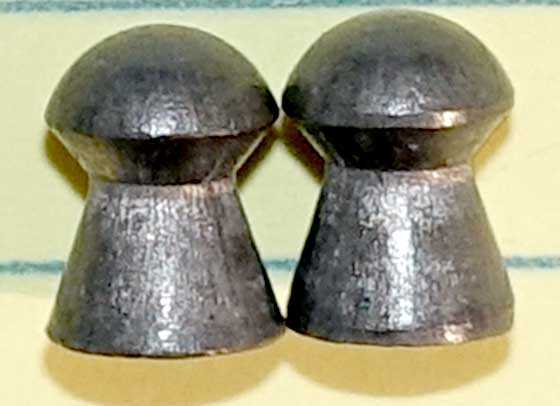
The rolled (sized) pellet is on the right. You can see a flat spot around the base of the skirt where the diameter has been reduced, and also around the head..
How deep is the pellet seated?
A couple people asked me whether I pushed the pellet past the dents into the case. I said I did in the report, and they asked me to show them how deep the pellet actually was. Here is that picture.
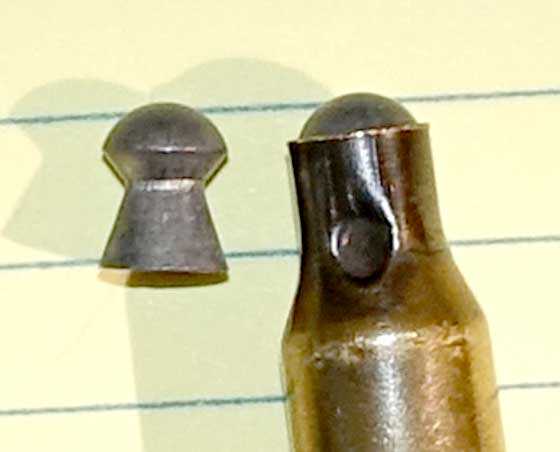
This picture shows how deep the pellet is seated. Obviously the pellet’s skirt goes past the dents (there’s one on either side).
Then someone asked me to seat a pellet as deep as I normally would and then remove it, so they could see the skirt for themselves. So I did that next.
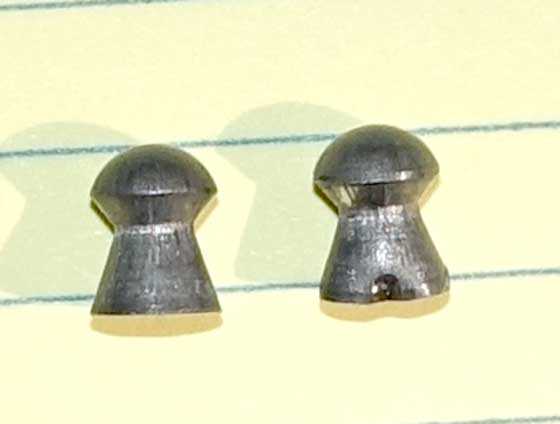
The pellet on the right was seated to the normal depth, then removed.
At this point I was thinking that there is no way this adaptor can work, with that amount of damage to the pellet. But this blog isn’t just about what I think. It’s about what actually is, and the only way to find that out is to test it.
A lot of “stuff” to support the adaptor
I set up my shooting bench at 10 meters and brought out all the stuff I need to reload the adaptor. It is a pile, I can tell you! Let’s look.
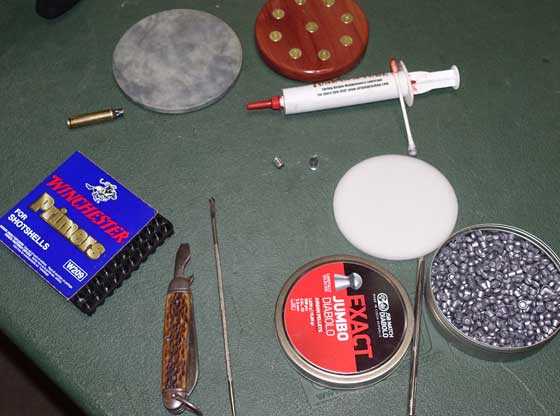
This is the stuff I used to load the adaptor.
The stuff
I needed pellets and primers, obviously. And something to push out the primers after I fired. I used one end of a cotton swab for that, and the other end I coated with Tune in a Tube grease to grease the o-ring in the base of the cartridge. That made the primers easy to install and remove. In the beginning I used my pocket knife to pry out the primer before greasing the o-ring. After I greased the o-ring the swab pressed it right out. I used the two coasters at the top of the picture to roll the pellet to size.
The test
I didn’t have much faith in this adaptor — perhaps I have mentioned that already. So my first shot was from 12 feet, and I just hoped to hit somewhere inside the pellet trap. My AR-15 has a Tasco 8-40 power scope mounted on it, so I dialed the power down to 8 and adjusted the sidewheel focus down to 10 yards. That gave me a fairly clear image of the target at 12 feet. Not knowing where the pellet would strike, I aimed at the center of the bull.
The first shot landed in line with the center of the bull and about 2.5-inches below the aim point. That was at 12 feet, so I knew the pellet would rise a little at 10 meters — if the adaptor and rifle proved to be accurate.
Benchrest
So I backed up to 10 meters and rested the rifle in a large sandbag. I drew an aim point on the target above the bull, figuring that if the adaptor was accurate that would put my shots into the black somewhere.
The first shot surprised me by going exactly where I thought it would — in line with the target center and at the bottom of the black. Maybe this thing really works?
Surprise!
The second shot went somewhere, but through the scope I could see no new holes in the target. Could it have gone to the same place as the first shot? If this was an accurate pellet rifle that is exactly where it would have gone, but through the scope I just could not see a second hole. So I walked down and looked closely — and there it was! The second pellet went to the same place as the first. I took a picture, in case the subsequent shots messed it up.
The second pellet didn’t want to seat, so I pushed the nose of the pellet down on the stone coaster to seat it. It went in the case much deeper than I had been loading, so I was ready to explain why it didn’t go to the same place — except it did!
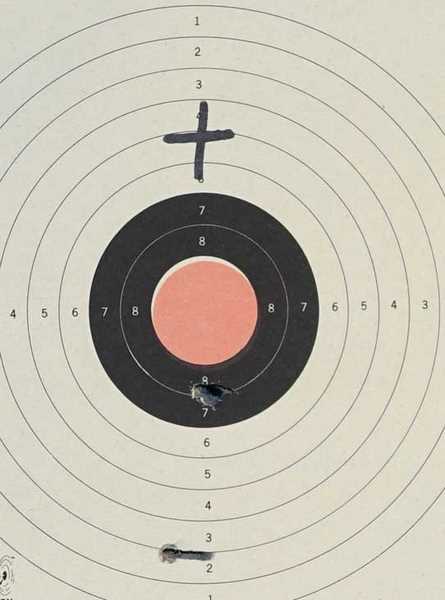
There is the target. The cross above the bull is the aim point. The hole below the bull is the first shot — the sighter from 12 feet. And, in the black at 6 o-clock there are two pellet holes touching each other!
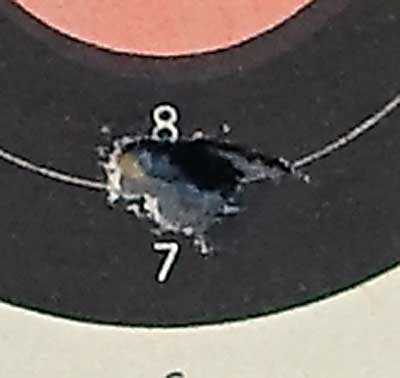
There are the two pellet holes.
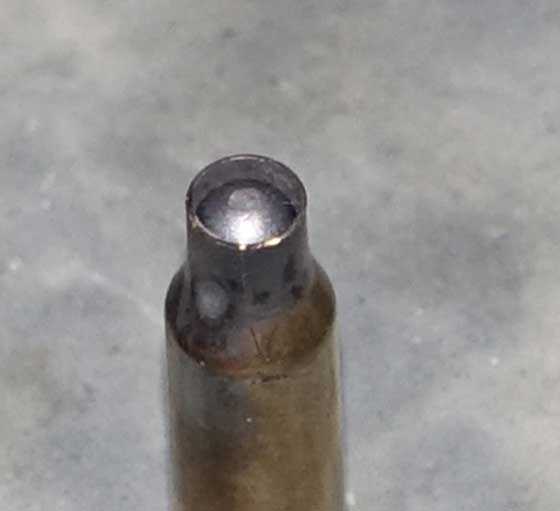
When the second pellet refused to seat I pushed it down against the stone coaster and this is what happened. After seeing the results of the second shot, I decided to seat all pellets this way.
Well, after a result like that I was astounded! This was unlike anything I ever expected or have seen in testing. I loaded a third pellet and seated it the same way as shot two. The pellet went to the same hole in the target!
Shot 4
The fourth shot was different. I rolled the pellet a little harder than before and was able to seat it all the way in the adaptor with my thumb. When I shot, the pellet struck the target at 3 o’clock about an inch away from the previous 3 shots. Well, I thought, that was just due to the difference in the way the pellet was seated, so I decided to shoot 2 more shots and finish the group at the bottom.
The next shot went into the group at the bottom, but shot 6 (which would have been the fifth shot for the bottom group) went to the same place as shot 4. I ended up with 2 groups — one having 4 shots and the other having just 2.
The larger group measures 0.44-inches between centers. All 6 shots measure 1.265-inches between centers. That’s not too shabby!
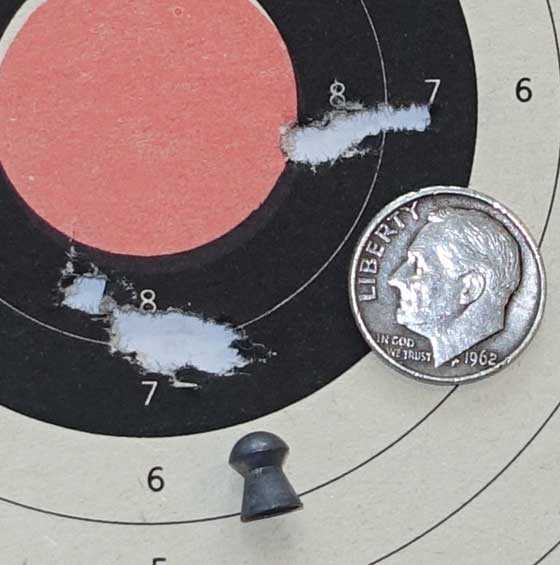
The large group of 4 shots at the bottom measures 0.44-inches between centers at 10 meters. The entire group measures 1.265-inches between centers.
Discussion
I think there is probably a knack to loading this adaptor to get the most accuracy out of it. But I am impressed by just whet we see here.
Is this for you? Well, if you don’t own an air rifle and do own a .22 centerfire that’s accurate, this might be worth a look. It gives you a pellet rifle of medium power and accuracy. But consider this, besides the cost of the pellet you are also using a shotgun primer that costs about 3-4 centsl, depending on how many you buy. It would cost no more to shoot .22 CB caps in a .22 rifle and you would have more power. Or buy a Walther Terrus in .22 and just shoot the pellets.
And finally there is the time it takes to do everything. I am a patient guy when I need to be, but this process bores me. It takes me a full 3 minutes or longer to get the next pellet ready. That’s why there is just one target today and only 6 shots fired for record. I doubt most people would want to do this. The adaptors are $15 each, so 5 of them will cost you $75. I don’t think this is the way people will want to go.

And don’t forget that you have to clean primer residue out of the barrel.
I agree: it wasn’t worth the trouble.
B.B.,
Thank You for the fine pictures at the top. Well, you proved that it does work. Thanks for the extra effort and your patience on getting it all done. Without going back and looking again, the larger caliber kits w/barrel inserts look to make a lot more sense,… for pistols if I re-call. I agree, for practice,…. just get a air gun copy of your firearm and be done with it. Heck, even air soft, as I seem to re-call right here that they are a more exact copy of their firearm counter parts. Quite the interesting side foray.
Good Day all,…… Chris
BB,
As you say, it was indeed interesting to explore, but I am so thankful you did this and not me. Your having done this will likely save quite a few people a lot of time and money to satisfy their curiosity, while if I had done such only I would have known.
Dittos. Not worth the hassle. But we appreciate all the hard work you spent.
BB,
Confession: I do own the convert-a-pell system, but I haven’t used it! Bought a couple years ago to use in a contender .223 barrel (don’t have one yet)!
Wondering if you’ve heard of the “Diana MPS Conversion System” for revolvers and pistols? Was distributed by Taurus. I found an ad in an American Handgunner magazine from around 1982. Used a .177 bbl liner and (I assume) primers. J. I. Galan wrote about it in a couple magazines and the 1982 Gun Digest.
Would send you a photo of the ad if possible.
Regards,
Nathan
Nathan,
No, I haven’t heard of that one. The one I tested was made by Convert-A-Pell, who also makes this one, I believe. The revolver adaptor was so poor that I had little hope for this one until I tested it.
Thanks for the offer of the info, but I’ll pass. I;m so backed up with writing as it is that my desk looks like a landfill! 😉
B.B.
B.B.,
As I do not have a .223 rimfire I read today’s report with, no offense, just slightly less interest than I usually have. HOWEVER, I am easily interested by what are sometimes relatively trivial things. Your pocket knife looks exactly like my Boy Scout knife (by Ulster). Does yours have the Boy Scouts emblem on the other side? I also still have my Cub Scout knife, too, which was originally my father’s cub scout knife.
I LOVE pocket knives and have a collection of dozens of them. Nothing fancy or especially valuable, but they are fun to collect. The best are antique hobo knives.
Michael
Michael,
My knife is a Camillus, which was the more common type. It is a genuine WW II camp knife issued by the Army. Says USA on the escutcheon.
B.B.
B.B.,
My Cub Scout knife is a Camillus. I also have an old Cattaraugus B.S.A. knife, but it wasn’t from my childhood.
My most valued pocket knives are a small Sabre (Japanese) my grandmother gave me for my birthday; my grandfather’s pocket knife, a Henckel’s from 1906 or so; and a Victorinox, a Buck, and an unbranded sailor knife all three of which belonged to my father-in-law.
I have a few fixed blade Camillus military pilot knives, too. They are the ones with the glass breaker, leather ringed grip, saw-back, and sew-on sheath for the air jumpsuit. Two are NOS surplus. My next door neighbor, who was a pilot in Vietnam, said the Air Force and Navy had the following criteria for Camillus: they had to have sheaths that could be sewn onto the jumpsuit, the had to have a tip that could pierce aircraft fuselage aluminum, and they had to have a saw that could cut through aircraft aluminum. Oh, and I think everyone has a PAL and a USMC bolo. :^)
My hiking knife is a Ka-bar and my pocket knife is a tiny Victorinox.
Michael
BB
The first thing that caught my attention was your picture of equipment used to make your ammo, including the pocket knife. I received a similar knife from my father when I was 12 years old, in 1963. Mine had a long, and short blade, a can opener, and a bottle cap remover. There was a small brass coloured half inch plaque on one side of the handle that simply read “camper”. It was most likely misplaced during one of my many moves in the 70’s, and 80’s. We have lived in our current home for almost 27 years now, with no expectations of moving the foreseeable future, but I still retain the possibility it will show up again when I least expect it. As my Leatherman is far more utilitarian then the basic “camper knife,” it is strictly for sentimental reasons I still hold out hope it will reveal itself one day.
As for the firearm pellet adaptor, it seems like a lot of fiddling to seat the pellet in the cartridge just so. Not to mention the price of producing 6 cartridges. The price of an accurate .22cal air rifle would pay for itself in 3, or 4 shooting sessions alone. However, I’m happy to see people thinking outside the box concerning firearms shooting pellets accurately. Someone reading this blog may see the potential of this system, and refine it to where it becomes affordable, and accurate to 30+ meters. That is how most inventions we now take for granted started. Wilbur, and Orville Wright didn’t just decide to try their hand at flying one day in 1903. They experimented with aerodynamics by flying gliders until they refined their gasoline engine powered airplane using the lessons learned from countless previous efforts, many with deadly consequences. They also needed to perfect a system to launch their plane from the sand dunes of Kitty-hawk. It wasn’t until they took their invention to Le Mans, France where heavier then air flight was all the rage, that the world finally took notice of the Wright Flyer. Reminds one of Jimi Hendrix having to travel to England to achieve fame before returning to America in triumph at the Monterey Pop Festival in 1967.
Ciao
Titus
Titus Groan,
At Monterrey Pop Jimi was flying high, too!
Michael
Michael
I’m thinking he was being it that time frame. But maybe he wasn’t flying high. You never know ya know. 🙂
Gunfun1,
Given the probable demographics of those friends of mine who frequent this forum (freedom-loving, gun-appreciating, Second Amendment-Defending, military-respecting), may I point out that John (James) Hendricks enlisted in the U.S. Army in the early 1960s and served in the 101st Airborne (101st AIRBORNE!) at Ft. Cambell. He received a medical discharged after he suffered a severely broken ankle during airborne exercises (rough landing with those low drops from a zip cord). Look: https://upload.wikimedia.org/wikipedia/commons/5/5e/Hendrix_in_Army.jpg
It is a good bet Hendrix was on pot from, perhaps 1966 through his death. In truth, however, he probably did far less serious drugs than people imagine.
I actually am acquainted with a guy who knew Hendrix a bit. They weren’t best buds or anything, but during the time when Hendrix was between The Experience and Band of Gypsies Jimi regularly jammed with whoever was around in one or two NYC clubs, very often including with the guy I know. Hendrix had two mind-alterers of choice and mostly avoided others. He enjoyed a couple beers here and there, but mostly he did LSD, occasionally, and marijuana, pretty much daily.
The night he died of accidental O.D. in London, he had mixed two sleeping pills (only because he was having insomnia) prescribed to his girlfriend, along with two or three beers. That’s it. In his sleep the combo, predictably, was bad. He threw up while VERY asleep, asphyxiated, and that was that. A simple and sad tale.
Everyone who ever knew him said Jimi was a kind, optimistic, generous, and engaging person.
Michael
Michael
Well if that wasn’t some interesting stuff I don’t know what is. 🙂
Titus
All true about someone taking something to the next step. I really do believe that the cartridge firing a pellet would work if the system was thought out a little better.
And that reminds me. What is the name of that air gun that uses a air cartridge similar to a firearm but is charged with 3000 psi if I remember right. You fill each cartridge with high pressure air (HPA) and load a pellet I believe in each cartridge.
I think the firearm pellet firing cartridge would work if more thought went into VB the design.
VB was not suppose to be in the sentence. Phone just ain’t been behaving today.
Michael
You meant .223 centerfire didn’t you.
Gunfun1,
Yep! I guess that reveals I am truly a non-firearm guy!
Michael
Michael
Ok thought that’s what you meant.
Michael
Well my response didn’t get worded right. Thought you did a misspell. Thought you meant centerfire not rimfire. Sorry about that.
Gunfun1,
I know so little about real guns that I mistakenly wrote rimfire. I did mean centerfire, I think, but I got discombobulated. .22 is rimfire, .223 Remington and NATO are centerfires. Did I finally get it, LOL? (Oh, and I do know the difference between the Remington and the NATO.)
Hey, I am clueless, but I do know a clip from a magazine!
Michael
Michael
Oh no not the clip and magazine thing. What is the difference anyway. One rotates and one don’t. 😉
Gunfun1,
As I understand it,
1st, “Clip” can refer to a strip of multiple magazines in military usage, as in, “Quick! We’re almost out of ammo. We need a couple clips. Every man is down to a mag or less!” These might even be called “Strip Clips.”
2nd, “Magazine” specifically refers to an ammo-dispensing device that includes in its operation a spring or other mechanism (including gases in the case of true semi-auto) that actively moves the individual rounds along towards the chamber.
3rd, a device that attaches to the weapon but is passive, which is to mean without motor or spring or gas or any other sort of device, to propel a round is often called a “clip.”
So, a BB ammo-holder with a spring in it is a magazine. A BB dispenser which is gravity or user operated is “merely” a clip.
If I am wrong, please, someone correct me. If I am correct, please, someone provide me with some positive reinforcement as this is not my forte. :^)
Michael
Michael
Clips are something a bullet or pellet is loaded in that advances the next pellet or bullet mechanically by other means that’s not a direct function of the device the pellet or bullet is loaded in.
A magazine is something that is spring loaded that advances the pellet or bullet into the chamber of the gun or into the barrel.
Example a 1077 has a clip. A Marauder has a magazine.
And I need to rephrase the last part.
A magazine is something that is spring loaded that advances the pellet or bullet (so it can be ready or chambered in the gun or barrel).
Michael
But yep we are talking about the same thing. 🙂
Michael,
You pretty much nailed it. However for those who are anal, there are some clips with springs. Stripper clips is a good example. The springs hold the cartridges in the clip — they do not assist in feeding them.
B.B.
BB
I asked about the side by side picture of the pellets in part 2. Here see. And didn’t look but Chris might of asked too.
“I would of liked to see a side by side picture of a pellet you sized the skirt on and one that comes straight from the tin. No particular reason why. Just would like to see the difference.”
Anyway did you try any pellets or seated where it messed the skirt up. I would think that would hinder performance.
GF1,
Did I try…? Yes. Every pellet I shot except the sighter and shot one was seated like the one shown.
B.B.
BB
I guess the head of the pellet would stick out of the case to far if you just touched the skirt on the dimples or whatever they are. To bad they didn’t make the dimples farther down the neck.
I imagine it wouldn’t be to hard to drill out the primer cavity on a regular casing from a gun. Then the shot gun primer could be used. Wouldn’t have to worry about the dimples and the neck of the casing would be sized to the gun it was used in. Probably would help to have access to machine shop equipment though. Maybe that would be the trick to get more accuracy out of the cartridge. Not that acurracy wasn’t too bad. Kind of bummer with the group’s in two different places though.
BB
And I meant on my comment above. Did you try any where the dimple (did not) mess up the skirt.
GF1,
No, I didn’t The problem then is the pellet is always cocked to one side, and I didn’t think that could be too accurate.
BB
Yep that’s what I figured would happen.
There doesn’t seem to be a lot of interest in using this conversion, but if one is on the fence about it, I have some suggestions that might make it more appealing. Firstly, I think one could make their own, avoiding most of the cost. In the eighties I bought a system for my 1911 that shot a wax and polymer blended semiwadcutter from an altered .45 ACP case with a large shot gun primer. There was no Oring for the primer, the pocket was just drilled out so the primer fit snuggly ( the bolt face kept it in when firing). then one of the “bullets” that they sold by the bag was pressed in under thumb pressure. Load the magazine and shoot. Press out the primer with a dowel of one’s choosing , reload, shoot. (don’t remember ever cleaning primer residue or any other maintenance between loadings) Six cartridges came with the kit but I wanted to be able to load a 50 round box at a time, so I drilled out some spent casings just like the purchased ones. When I shot up the polymer bullets I pressed the cases into a bar of wax to make wax slugs, leaving, basically, the cost of the primers. Was accurate enough to hit small sized baby food jars at 40 feet, off hand.
My second suggestion is that a die to quickly and repeatably resize the pellet skirts could be made by using a #1, #2, #3, or 7/32″ drill. Because of runout ,sharpness of drill, and material you choose to drill, etc, you will have to experiment with the different sizes until you get the result that makes the pellet easy to load. I did this in an experiment to resize and reshape the skirts on cheap, poorly performing pellets to make them better. The die was easy to make from some scrap 3/8″ UHMW plastic sheet I had lying around, but the experiment was a bust.
How very appropriate. This reminds me of my last reloading session. There I was reloading a bunch of cases that I had not resized properly, so I had to deprime them and start all over again. This time I got it right. Everyone was perfect with me trickling in the powder to the exact particle. I had finished 60 and was ready to seat the bullet on the last one for complete perfection. But previously I had noticed that, unlike 30-06, if the bullet was not placed exactly upright in the case it would get stuck sideways. Before, I had stopped as soon as I felt resistance and straightened the case. This time in a burst of confidence, I pulled the press handle, expecting the case to be forced into correct position like the 30-06. Instead, my whole bullet got jammed in below the case mouth, looking just like the pellet in the blog. I had to pull the bullet and start the whole reloading process over again. It was enough to make me want to shout with frustration, but, to quote the boxer Floyd Mayweather Jr., “Some things you just have to learn.”
Anyway, I too would recommend buying an airgun rather than loading pellets into cases.
Matt61
Hi BB,
It’s been a while since I posted, I read regularly still. Still mostly in the silent air gunner category. This is a fun post, as you mentioned, I think a bit labor intensive. I have played with using foam ear plugs in a .41 revolver using a regular large pistol primer. Not very accurate, but good enough for a bit of fast draw practice at 10′. It was fun for a while.
I have a subject change for you. I was very interested in your report about the Bubble Leveler Scope last year. Santa Clause was kind enough to bring me one. I have never had a high end scope, and this is maybe the clearest, brightest scope I have ever looked through. However I thought it was defective as I had a very poor view of the level while looking through the scope positioned to shoot the gun. I could see the bubble if I lifted my head a bit so as to look down into the scope a bit, but that defeats the whole purpose if I have to move in order to see it. I returned it to Pyramid Air and they sent me another one. The replacement is exactly the same. Am I possibly missing something?
I remember your excitement with the visibility of the level. Have you heard about anyone else with this problem? Trying to decide if I got a second defective one and ask for another replacement, or just ask for a refund. I appreciate your thoughts on the matter.
Thanks, Mark
Mark,
Welcome back!
No, your scope is not defective. The bubble can be difficult to see, yet when I tested it I could see it even in low light. It’s something that has to be learned.
B.B.
BB
FWIW,
Here is some results that I did using 22 cal pellets in CF cases, in the 80’s,
I had an OLD BA rifle in a Savage 340, 22 Hornet caliber, bore diameter was .223″,
that was my “Yeller Dog” calling rifle for heavy brush etc.
I made up 6 cases this way, I used fire formed cases from the Hornet chamber,
I drilled the primer pocket web out to 1/8″ diameter,
inserted a steel rod all the way thru to the case head, then filled the cases with molten lead.
After the lead had turned solid, (while keeping the rod centered as close as possible),
I pulled out the rod, which left 1/8″ thru the case, then chucked the cases up in the lathe,
and fitted a 209 shotgun primer, so I could just push a primer into the cases,
counter sunk enough for the correct head space etc.
Then a tapered pin reamer was used to to cut a tapered hole thru to the case mouth,
leaving just enough lead to have a ledge inside the case neck,
too seat a 22 cal pellet even with the end case mouth.
Used a washer with hole larger than the 210 primer,
and using a bent nail “L” shaped that small enough to fit thru the case,
to push out the fired primer.
The pellet was seated via pushing it into the case skirt first,
until the skirt just contacted the inside ledge of the lead filled case,
and have the pellet nose even with the case mouth,
then shotgun primer was inserted into the case head,
to be seated when chambered etc.
These cases with pellets were accurate enough, (once I learned where they grouped at),
that head shots on cottontails were in very dangerous area out to 20-25 yds,
if I did my part, and these loads were quite enough to use for rabbits,
when sneaking into calling spots, and not spooking the target varmints etc.
HTH,
Tia,
Don
Don,
Welcome to the blog.
By coincidence I just filmed the adaptor for American Airgunner yesterday!
B.B.
BB
Thank you, I am enjoying your info in all the posts, quite refreshing and very accurate info etc.
I have never joined Blog before, so I am not sure what I should be doing here.
I have been reading ALL the info that is posted at Pyramyd AIR reports etc,
it will be at least a couple weeks reading, I am finding out, LOL,
attempting to find all the info I can on the following Air force models,
Condor, Talon models, this is my first time attempting to buy a good hunting air rifle,
for pest, varmints and small game etc.
I want a 22 caliber, accurate out to <50 yds,
with enough power to accurately/humanely take the critters from,
Starling, English sparrow, Magpies, Skunks, Badgers and occasionally coyotes,
that are sneaking in on the chickens etc, and are around the ranch causing problems etc.
Just had a NEW neighbor that moved in (from CA) and objects to my use of firearms around the ranch, 10 acres, even thou they are over 1/4 mile away, they complain about the noise and possible bullets flying around etc, calls the SO (Sheriffs Dept) and they are told that I am licensed to have my gun shop here etc,
so deal with it.
(36 yrs retired from this SO, they don't know that) yet.
Main reason for the Air Rifle questions etc, New field for me.
But, still be able to do some back yard informal target shooting,
and training the G-kids to become firearm familiar etc.
I am UNABLE to find the differences so far between these models, yet (lot to read etc).
I am 6' tall and long armed, take a 14+" pull.
Any suggestion??
Tia,
Don
Don,
When you add coyotes to the list everything changes. Until then I recommend a Diana 34P, or if money is no object, a TX200 Mk III.
Throw in coyotes and we HAVE to move to a PCP.
Perhaps the Hatsan BT65? But that will overpower all the other game on your list.
So, lets do this. Let’s buy a car for over the road and save up for a tractor to plow the fields.
Remember this, the man with one rifle becomes proficient with it.
B.B.